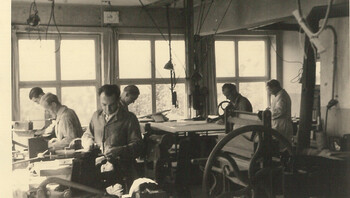100 years
Marbach Group
2. March 2023
100 years of Marbach (Part 2) 1939 - 1945: The War Years.
We celebrate a great milestone in 2023: the company will turn 100. In the 1920s, Karl Marbach Senior had managed to found a small craftsman's business and to successfully lead it out of the world economic crisis with the help of a new product – steel rule dies – as well as some new customers. (More about this in the first part of this series: "100 Years Marbach. 1923 - 1927: The founding years.") But only a short time later, the next difficult years were already approaching the infant company, as another worldwide crisis was soon to begin with the Second World War.
Prior to the outbreak of the Second World War, the Marbach family had moved to their new home at the company's headquarters in Fügerstrasse. In addition to steel rule dies for the advertising industry, the company had also been producing tools for the sealing industry during this time. Before founding the company, Karl Marbach Senior had worked for, among others, the KACO company, which produced seals. Here he had also become acquainted with the technology for manual top knives, formerly main product of the company.
Shortly after, in 1939, the second world war broke out. Karl Marbach Senior was called up to serve in the homeland security in Heilbronn. But even this did not stop the Marbach family from continuing to operate the company. The broad portfolio now paid off: because during the Second World War, the company was not forced to close, since tools for the production of seals for engines, transmissions and pumps were urgently needed. In order to maintain the parental business, the founder's son, Karl Marbach Junior, born in 1927, ran errands for his mother during the war years. Back and forth he delivered offers, calculations and declarations of workmanship between the couple's home and the fire station, where Karl Senior performed his homeland security duties. This allowed Marie Marbach to keep the business going during this time.
From 1942 to 1945, Karl Marbach Junior was apprenticed as a mechanic in his parents' company. Due to the war situation, his training was shortened. Later, he studied precision mechanics and quantity production at the Esslingen State School of Engineering.
Surviving the first years of the war relatively well, the company was hit hard, in the truest sense of the word, at the end of 1944. On December 4, Heilbronn – which had been an important railroad hub during the war – was more than 60% destroyed in an air raid by the British Royal Air Force. Part of the Marbach plant was also badly damaged: the building in Fügerstrasse was badly damaged, with an entire corner of the house missing and the roof blown off. In order to be able to keep up production, at least provisionally, the workshop was moved to the birthplace of Karl Marbach Senior in Unterheinriet.
In the last days of fighting of the Second World War, the provisional workshop in Unterheinriet was also destroyed. This happened in April 1945, but even this setback did not stop Marbach: from the remains of the business, the company temporarily set up a locksmith's workshop in an old, disused cattle barn.
Things got even worse for the Marbach family however. In 1945, Karl Marbach Junior became an American prisoner of war and was sent to perform labor service in the Regensburg area. Despite his young age, he had actually wanted to volunteer for military service beforehand, but his father had forbidden it: "You will stay at home and do an apprenticeship. I can beat you here, you don't need to go to war for that." That same year, the 18-year-old was released from his captivity at the New Castle in Stuttgart.
After the war, Karl Marbach Senior was able to repair the residential building in Fügerstrasse together with an employee called Willi Schweiker, and so the business could be moved back to Heilbronn. Once more, they had to start from scratch again. But this is where Marbach's good network paid off: the first steel rule was provided by a customer who was able to move freely in the occupation zones. Later, Karl Marbach Senior managed to travel twice to Wuppertal which was in the British occupation zone in order to obtain steel rules from the company Wilhelm Eßmann Werkzeugfabrik (today Essmann + Schäfer). He traded a sack of flour that the Marbach family had received from an acquaintance miller for two 100 meter rings of steel rule. He could not transport more material with the cart.
The newly started production initially included steel rule dies (cutting-dies) for the engine and sealing industry, but increasingly also for the advertising and packaging industry. Once again, the Marbach company had managed to fight its way out of a crisis.
This perseverance paid off. In the 1950s, with Karl Marbach Junior, the second generation joined the company and with him came many new ideas and plans. It was he who visited an exhibition for the first time in the company's history in 1966. In the third part of this series, you will learn how this would have such a lasting influence on the development of the company: "100 years of Marbach. Successful exhibitor: The trade fairs."

